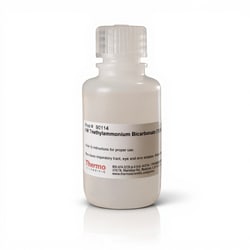missing translation for 'onlineSavingsMsg'
Learn More
Learn More
Thermo Scientific™ 1M TEAB and 50% Hydroxylamine Buffers for TMT Experiments
Shop All Thermo Scientific Products
Click to view available options
Product Type:
Hydroxylamine
TEAB
Unit Size:
50mL
5mL
Description
Pre-formulated TEAB and 50% hydroxylamine designed for use in TMT labeling and quenching of peptides.
Triethylamonium bicarbonate (TEAB) is a 10X dissolution buffer for isobaric mass tag labeling experiments. 50% hydroxylamine is a 10X quenching reagent for amine-reactive labeling for TMT experiments.

Specifications
Specifications
| Product Type | TEAB |
| Product Line | TMT |
| Content And Storage | Store protected from direct sunlight in a dry, cool, and well-ventilated area. |
| Starting Material | Cell Lysate |
| Workflow Step | Protein Labeling |
| Quantity | 50 mL |
Safety and Handling




Product Identifier
- 1M TEAB and 50% Hydroxylamine Buffers for TMT Experiments
- Danger
- Acute toxicity Category 4
- ACUTE AQUATIC Acute 1
- Carcinogenicity Category 2
- Serious eye damage/eye irritation Category 1
- Substances and mixtures corrosive to metals Category 1
- Skin corrosion/irritation Category 2
- Skin sensitiser Category 1
- Specific target organ toxicity after repeated exposure Category 2
- Specific target organ toxicity Category 3
- H290-May be corrosive to metals.
- H302-Harmful if swallowed.
- H312-Harmful in contact with skin.
- H315-Causes skin irritation.
- H317-May cause an allergic skin reaction.
- H318-Causes serious eye damage.
- H335-May cause respiratory irritation.
- H351-Suspected of causing cancer.
- H373-May cause damage to organs.
- H400-Very toxic to aquatic life.
- P102-Keep out of reach of children.
- P280-Wear protective gloves/protective clothing/eye protection/face protection.
- P284-¢In case of inadequate ventilation! wear respiratory protection.
- P304+P340-IF INHALED: Remove person to fresh air and keep comfortable for breathing.
- P305+P351+P338-IF IN EYES: Rinse cautiously with water for several minutes. Remove contact lenses, if present and easy to do. Continue rinsing.
- P405-Store locked up.
- P501b-Dispose of contents/container in accordance with local/regional/national/international regulations.
- MIXTURE LIST-Contains : hydroxylamine
Product Content Correction
Your input is important to us. Please complete this form to provide feedback related to the content on this product.
Product Title
Spot an opportunity for improvement?Share a Content Correction
